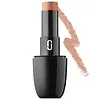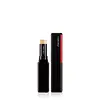Marc Jacobs Beauty Accomplice Concealer & Touch-Up Stick Versus Shiseido Synchro Skin Correcting Gelstick Concealer
What's inside
What's inside
 Key Ingredients
Key Ingredients

 Benefits
Benefits

 Concerns
Concerns

 Ingredients Side-by-side
Ingredients Side-by-side

Hydrogenated Polydecene
EmollientSilica
AbrasiveDiphenylsiloxy Phenyl Trimethicone
Skin ConditioningOctyldodecanol
EmollientCyclopentasiloxane
EmollientPolyethylene
AbrasiveDipentaerythrityl Hexahydroxystearate/Hexastearate/Hexarosinate
Skin ConditioningHydrogenated Polyisobutene
EmollientCopernicia Cerifera Cera
EmollientParaffin
PerfumingAcrylates/Dimethicone Copolymer
Skin ConditioningTriethoxycaprylylsilane
Phytosteryl Isostearyl Dimer Dilinoleate
EmollientCera Microcristallina
Emulsion StabilisingSorbitan Sesquioleate
EmulsifyingMica
Cosmetic ColorantGlycerin
HumectantDipropylene Glycol
HumectantWater
Skin Conditioning1,2-Hexanediol
Skin ConditioningIsopropyl Palmitate
EmollientTocopheryl Acetate
AntioxidantQuaternium-18 Bentonite
Caprylyl Glycol
EmollientDimethicone
EmollientPolyglyceryl-10 Oleate
Skin ConditioningHydrogenated Lecithin
EmulsifyingPropylene Carbonate
SolventEthylhexylglycerin
Skin ConditioningAdenosine
Skin ConditioningQuartz
AbrasiveButylene Glycol
HumectantTremella Fuciformis Polysaccharide
Emulsion StabilisingGlobularia Alypum Leaf Extract
Skin ConditioningEthyl Hexanediol
SolventTocopherol
AntioxidantBHT
AntioxidantTitanium Dioxide
Cosmetic ColorantIron Oxides
CI 77742
Cosmetic ColorantHydrogenated Polydecene, Silica, Diphenylsiloxy Phenyl Trimethicone, Octyldodecanol, Cyclopentasiloxane, Polyethylene, Dipentaerythrityl Hexahydroxystearate/Hexastearate/Hexarosinate, Hydrogenated Polyisobutene, Copernicia Cerifera Cera, Paraffin, Acrylates/Dimethicone Copolymer, Triethoxycaprylylsilane, Phytosteryl Isostearyl Dimer Dilinoleate, Cera Microcristallina, Sorbitan Sesquioleate, Mica, Glycerin, Dipropylene Glycol, Water, 1,2-Hexanediol, Isopropyl Palmitate, Tocopheryl Acetate, Quaternium-18 Bentonite, Caprylyl Glycol, Dimethicone, Polyglyceryl-10 Oleate, Hydrogenated Lecithin, Propylene Carbonate, Ethylhexylglycerin, Adenosine, Quartz, Butylene Glycol, Tremella Fuciformis Polysaccharide, Globularia Alypum Leaf Extract, Ethyl Hexanediol, Tocopherol, BHT, Titanium Dioxide, Iron Oxides, CI 77742
Hydrogenated Polydecene
EmollientCI 77891
Cosmetic ColorantCI 77492
Cosmetic ColorantKaolin
AbrasiveMica
Cosmetic ColorantCyclopentasiloxane
EmollientDiphenylsiloxy Phenyl Trimethicone
Skin ConditioningCI 77491
Cosmetic ColorantParaffin
PerfumingLithium Magnesium Sodium Silicate
AbsorbentSorbitan Sesquiisostearate
EmulsifyingPolyethylene
AbrasiveCI 77499
Cosmetic ColorantCI 77120
Cosmetic ColorantGlycerin
HumectantDimethicone/Vinyl Dimethicone Crosspolymer
Skin ConditioningCopernicia Cerifera Wax
Microcrystalline Wax
Emulsion StabilisingWater
Skin ConditioningIsododecane
EmollientPhenoxyethanol
PreservativePEG-10 Dimethicone
Skin ConditioningPolysilicone-2
Hydrogenated Polyisobutene
EmollientAluminum Hydroxide
EmollientSynthetic Fluorphlogopite
Disteardimonium Hectorite
StabilisingEthylene/Propylene/Styrene Copolymer
Simethicone
EmollientButylene Glycol
HumectantPropylene Carbonate
SolventTocopherol
AntioxidantAgar
MaskingNacre Powder
AbrasivePolymethylsilsesquioxane
Polyquaternium-51
Skin ConditioningStearic Acid
CleansingTriethoxysilylethyl Polydimethylsiloxyethyl Dimethicone
Skin ConditioningButylene/Ethylene/Styrene Copolymer
Thymus Serpyllum Extract
Skin ConditioningAlumina
AbrasiveSericin
Skin ConditioningSodium Acetylated Hyaluronate
HumectantBHT
AntioxidantCitric Acid
BufferingPotassium Sorbate
PreservativeHydrogenated Polydecene, CI 77891, CI 77492, Kaolin, Mica, Cyclopentasiloxane, Diphenylsiloxy Phenyl Trimethicone, CI 77491, Paraffin, Lithium Magnesium Sodium Silicate, Sorbitan Sesquiisostearate, Polyethylene, CI 77499, CI 77120, Glycerin, Dimethicone/Vinyl Dimethicone Crosspolymer, Copernicia Cerifera Wax, Microcrystalline Wax, Water, Isododecane, Phenoxyethanol, PEG-10 Dimethicone, Polysilicone-2, Hydrogenated Polyisobutene, Aluminum Hydroxide, Synthetic Fluorphlogopite, Disteardimonium Hectorite, Ethylene/Propylene/Styrene Copolymer, Simethicone, Butylene Glycol, Propylene Carbonate, Tocopherol, Agar, Nacre Powder, Polymethylsilsesquioxane, Polyquaternium-51, Stearic Acid, Triethoxysilylethyl Polydimethylsiloxyethyl Dimethicone, Butylene/Ethylene/Styrene Copolymer, Thymus Serpyllum Extract, Alumina, Sericin, Sodium Acetylated Hyaluronate, BHT, Citric Acid, Potassium Sorbate
Ingredients Explained
These ingredients are found in both products.
Ingredients higher up in an ingredient list are typically present in a larger amount.
BHT is a synthetic antioxidant and preservative.
As an antioxidant, it helps your body fight off free-radicals. Free-radicals are molecules that may damage your skin cells.
As a preservative, it is used to stabilize products and prevent them from degrading. Specifically, BHT prevents degradation from oxidation.
The concerns related to BHT come from oral studies; this ingredient is currently allowed for use by both the FDA and EU.
However, it was recently restricted for use in the UK as of April 2024.
Learn more about BHTButylene Glycol (or BG) is used within cosmetic products for a few different reasons:
Overall, Butylene Glycol is a safe and well-rounded ingredient that works well with other ingredients.
Though this ingredient works well with most skin types, some people with sensitive skin may experience a reaction such as allergic rashes, closed comedones, or itchiness.
Learn more about Butylene GlycolCyclopentasiloxane, or D5, is a silicone used to improve texture of products and trap moisture.
D5 is considered lightweight and volatile. Volatile means it evaporates quickly after application. Once evaporated, D5 leaves a thin barrier that helps keep skin hydrated.
It is also an emollient. Emollients help soften the skin and prevent water loss. Silicones create a silky texture in products. D5 helps other ingredients become more spreadable.
Studies show D5 is safe to use in skincare products. We recommend speaking with a skincare professional if you have concerns.
Learn more about CyclopentasiloxaneDiphenylsiloxy Phenyl Trimethicone is a silicone. It has a high refractive index and adds shine to formulations.
According to the safety review by the Cosmetic Ingredient Review (CIR) Expert Panel, it is safe for use in cosmetics under the current practices and concentrations.
Glycerin is already naturally found in your skin. It helps moisturize and protect your skin.
A study from 2016 found glycerin to be more effective as a humectant than AHAs and hyaluronic acid.
As a humectant, it helps the skin stay hydrated by pulling moisture to your skin. The low molecular weight of glycerin allows it to pull moisture into the deeper layers of your skin.
Hydrated skin improves your skin barrier; Your skin barrier helps protect against irritants and bacteria.
Glycerin has also been found to have antimicrobial and antiviral properties. Due to these properties, glycerin is often used in wound and burn treatments.
In cosmetics, glycerin is usually derived from plants such as soybean or palm. However, it can also be sourced from animals, such as tallow or animal fat.
This ingredient is organic, colorless, odorless, and non-toxic.
Glycerin is the name for this ingredient in American English. British English uses Glycerol/Glycerine.
Learn more about GlycerinHydrogenated Polydecene is an emollient. It creates a non-occlusive film on the skin that offers extra protection for your skin barrier.
The texture of Hydrogenated Polydecene ranges from light and silky to rich.
Hydrogenated Polydecene is the end compound of controlled hydrogenation of Polydecene.
Learn more about Hydrogenated PolydeceneHydrogenated Polyisobutene is a synthetic polymer. Polymers are compounds with high molecular weight. Hydrogenated Polyisobutene is an emollient and texture enhancer.
In one study, Hydrogenated Polyisobutene showed better skin hydration levels than Caprylic/Capric Triglyceride. As an emollient, it helps keep your skin soft and hydrated by trapping moisture in.
Hydrogenated Polyisobutene is often used as a mineral oil replacement.
Learn more about Hydrogenated PolyisobuteneMica is a naturally occurring mineral used to add shimmer and color in cosmetics. It can also help improve the texture of a product or give it an opaque, white/silver color.
Serecite is the name for very fine but ragged grains of mica.
This ingredient is often coated with metal oxides like titanium dioxide. Trace amounts of heavy metals may be found in mica, but these metals are not harmful in our personal products.
Mica has been used since prehistoric times throughout the world. Ancient Egyptian, Indian, Greek, Roman, Aztec, and Chinese civilizations have used mica.
Learn more about MicaParaffin is a solid created from petroleum. The term 'paraffin' can also refer to either
petroleum jelly or mineral oil.
It has natural occlusive properties which can worsen oily skin. Due to its petrolatum base, this ingredient is not fungal-acne safe.
Polyethylene is a synthetic ingredient that helps the skin retain moisture. It is a polymer.
It is also typically used within product formulations to help bind solid ingredients together and thicken oil-based ingredients. When added to balms and emulsions, it helps increase the melting point temperature.
This ingredient is a solvent. It helps dissolve active ingredients and alter the texture of products.
Propylene Carbonate is commonly used in makeup and with clay, such as montmorillonite or bentonite.
Studies show this ingredient to be safe for cosmetics. When it is undiluted, it can cause skin irritation. (It is always diluted in skincare and makeup). This ingredient is water-soluble.
Propylene Carbonate is created from propylene glycol and carbonic acid.
Learn more about Propylene CarbonateTocopherol (also known as Vitamin E) is a common antioxidant used to help protect the skin from free-radicals and strengthen the skin barrier. It's also fat soluble - this means our skin is great at absorbing it.
Vitamin E also helps keep your natural skin lipids healthy. Your lipid skin barrier naturally consists of lipids, ceramides, and fatty acids. Vitamin E offers extra protection for your skin’s lipid barrier, keeping your skin healthy and nourished.
Another benefit is a bit of UV protection. Vitamin E helps reduce the damage caused by UVB rays. (It should not replace your sunscreen). Combining it with Vitamin C can decrease sunburned cells and hyperpigmentation after UV exposure.
You might have noticed Vitamin E + C often paired together. This is because it is great at stabilizing Vitamin C. Using the two together helps increase the effectiveness of both ingredients.
There are often claims that Vitamin E can reduce/prevent scarring, but these claims haven't been confirmed by scientific research.
Learn more about TocopherolWater. It's the most common cosmetic ingredient of all. You'll usually see it at the top of ingredient lists, meaning that it makes up the largest part of the product.
So why is it so popular? Water most often acts as a solvent - this means that it helps dissolve other ingredients into the formulation.
You'll also recognize water as that liquid we all need to stay alive. If you see this, drink a glass of water. Stay hydrated!
Learn more about Water